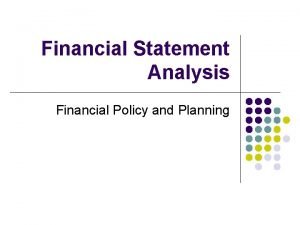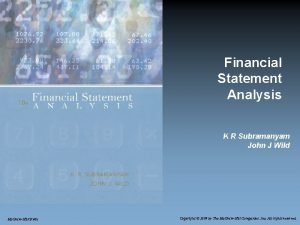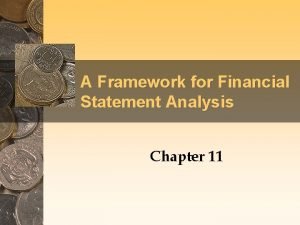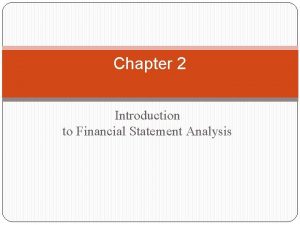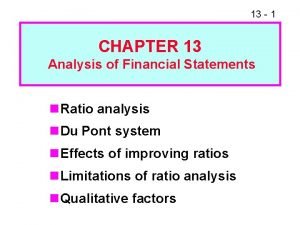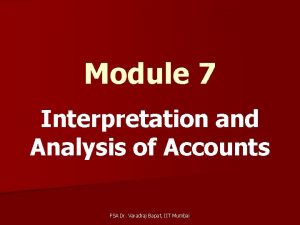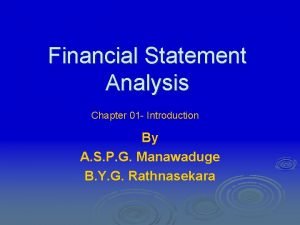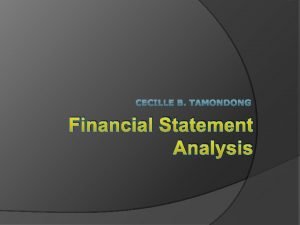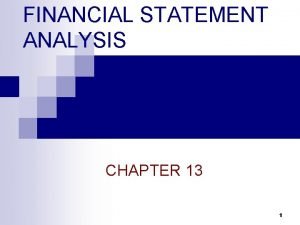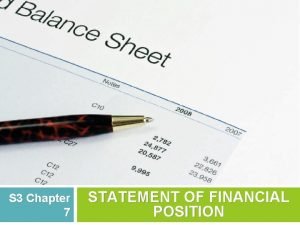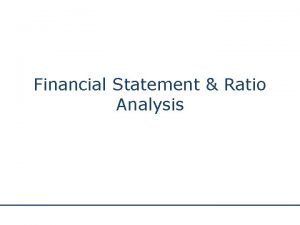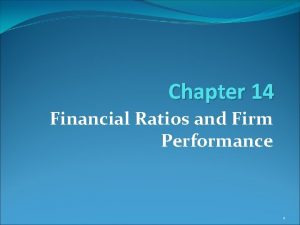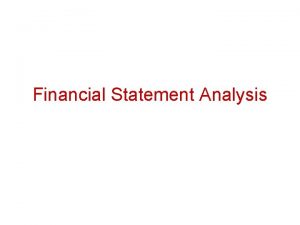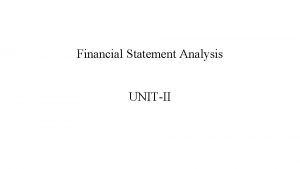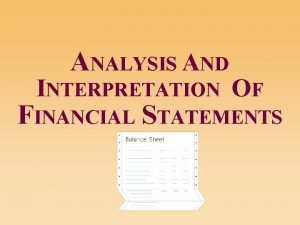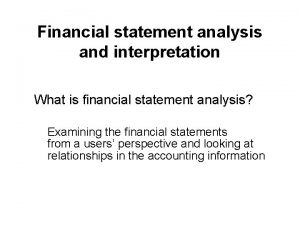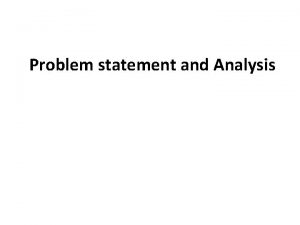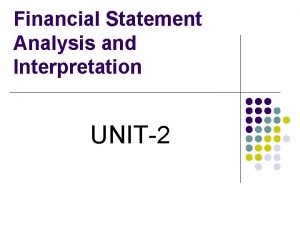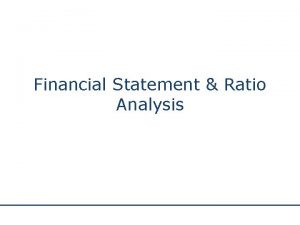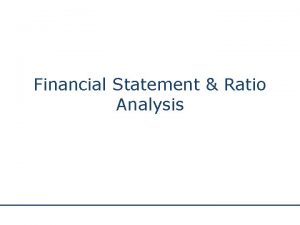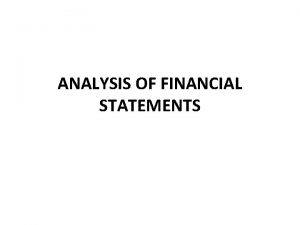Week 13 ANALYSIS AND INTERPRETATION OF FINANCIAL STATEMENT





















- Slides: 21

Week 13: ANALYSIS AND INTERPRETATION OF FINANCIAL STATEMENT

LEARNING OBJECTIVES 1. Explain the purpose of analyzing and interpreting the financial statement. 2. Calculate and interpret the most commonly used accounting ratios. 3. Access an organization’s profitability, liquidity, efficiency and solvency using ratio analysis. 4. Identify the limitation of financial statement analysis

The importance of financial statement analysis • Helps interested users in making economic decisions: – Provide the trend of the business for a certain period of time. – Provide comparability among companies in the same industry. • Helps in forecasting the business’s future performance

Users of financial statement • • Managers Investors / Shareholders Potential Investors Creditors Regulatory Agencies Inland Revenue Consumers

Financial Ratios Main Group Financial Ratio Profitability Ratio • Gross Margin Profit • Net Profit Margin • Return on Asset Liquidity Ratio • Current Ratio Efficiency Ratio • Average Collection Period • Quick Ratio • Stock Turnover Solvency Ratio • Debt Ratio

Profitability Ratio • • • These ratio measure the performance of a business during an accounting period. Focus primarily on the relationship between operating results as reported in the income statement and the resources available to the business as reported in the balance sheet. The ratio are : § Gross Profit Margin § Net Profit Margin § Return on Asset (ROA)

Profitability Ratio • Gross Profit Margin = Gross Profit / Net Sales • Net Profit Margin = Net Profit Margin / Net Sales • Return on Asset = (Net Profit After Tax) / Total Asset

Profitability Ratio – Return on Assets The rate earned on total assets measures the profitability of total assets, without considering how the assets are financed. Net income after tax Return on assets = Total assets

Eg: 2001 Net income 10, 600 Total Assets Return on Assets 75, 000 = 10, 600 75, 000 = 0. 14 ****It indicates that ROA is 14% which means that for every RM 1 spent on asset’s investment, the return out of total assets is 14%.

Gross Profit Margin & Net Profit Margin • Gross Profit Margin = Gross Profit / Net Sales • It measures how efficient are the business producing their products to generate sales. • The greater the sales, the better gross profit ratio. • Net Profit Margin = Net Profit Margin / Net Sales • It indicates the firm’s capacity to face changes in economic conditions such as price competition and low demand. • The higher the ratio, the better the profitability.

Liquidity Ratio • Current Ratio = Current Asset / Current Liability • Quick Ratio = (Cash + Account Receivable) / Current Liabilities

Current Ratio Current ratio measures liquidity in general and is mostly used to analyse financial position or liquidity of a firm as a short period. Formula = Current Ratio = Current Asset / Current Liability Example: Cash RM 10, 000, Account Receivables RM 25, 000, Machinery RM 45, 000 and Creditors RM 20, 000 Current Ratio = (RM 10, 000 + RM 25, 000) / RM 20, 000 = RM 35, 000/RM 20, 000 = 1. 75 It shows that current ratio has higher liquidity level and indicate that the firm able to pay its current obligations on time when it comes due.

Quick Ratio Quick ratio refers to the ratio of liquid assets to current liabilities. Formula = (Cash + Account Receivable) / Current Liabilities Example: Cash RM 20, 000, Account Receivables RM 25, 000, Inventory RM 12, 000, Machinery RM 45, 000 and Creditors RM 20, 000 Current Ratio = (RM 20, 000 + RM 25, 000) / RM 20, 000 = RM 45, 000/RM 20, 000 = 2. 25 It shows that quick ratio has higher liquidity level and indicate that the firm has the ability to meet its current liabilities on time and more liquid.

Efficiency ratio • Average Collection Period = (Debtor or Account Receivable x 360) / Net Sales • Stock Turnover = Cost Of Good sold / Average Stock

Efficiency Ratio – Average Collection Period Used to assess the liquidity of the receivables. It measures the number of times, on average, receivables are collected during the period. Receivables turnover = Debtor or Account Receivables x 360 Net Sales

2001 Eg: Net Sales 350, 000 Accounts Receivable Average Collection Period 9, 800 9800 x 360 = 350, 000 = 10. 08 days It indicates that the business take 10. 08 days to collect debts from the debtors.

Efficiency Ratio – Stock Turnover measures the number of times, on average, the inventory is sold during the period. Purpose: to measure the liquidity of the inventory. Inventory Turnover Cost of goods sold = Average stock Opening inventory + closing inventory Average stock = 2

2001 Eg: Cost of goods sold 50, 000 Stock Turnover 20, 000 50, 000 = 2. 5 times It means that the stocks had been replaced 2. 5 times within the financial period. The higher the stock turnover, the better and efficient company in managing their stocks for sale.

Solvency Ratio • Debt Ratio = Total Liabilities / Total Assets

Solvency Ratio – Debt Ratio measures the percentage of total assets provided by creditors. Total liabilities Debt ratio = Total assets

2001 Eg: Total assets 75, 000 Total liabilities 39, 000 Debt ratio = 39, 000 75, 000 = 0. 52 @ 52% The lower the debt ratio, the better the business in managing their debt.
 How does interpretation b differ from interpretation a
How does interpretation b differ from interpretation a Week by week plans for documenting children's development
Week by week plans for documenting children's development Financial statement analysis and planning
Financial statement analysis and planning Summary of ratio analysis
Summary of ratio analysis Financial statement analysis subramanyam ppt chapter 2
Financial statement analysis subramanyam ppt chapter 2 Chapter 14 financial statement analysis solutions
Chapter 14 financial statement analysis solutions Framework for financial analysis
Framework for financial analysis Chapter 2 financial statement analysis solutions
Chapter 2 financial statement analysis solutions Financial statement analysis objectives
Financial statement analysis objectives Chapter 13 financial statement analysis
Chapter 13 financial statement analysis Module 7 financial statement analysis
Module 7 financial statement analysis Introduction of financial statement analysis
Introduction of financial statement analysis Commercial bank income statement
Commercial bank income statement What is vertical financial statement analysis
What is vertical financial statement analysis Chapter 13 financial statement analysis
Chapter 13 financial statement analysis Internal users of financial reports
Internal users of financial reports Chapter 1 overview of financial statement analysis
Chapter 1 overview of financial statement analysis Tangible net worth
Tangible net worth Chapter 14 financial statement analysis
Chapter 14 financial statement analysis What is art analysis
What is art analysis Example of analysis and interpretation of data
Example of analysis and interpretation of data Analyze vs interpret
Analyze vs interpret


